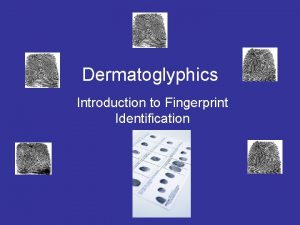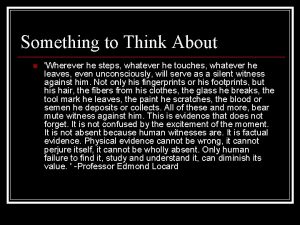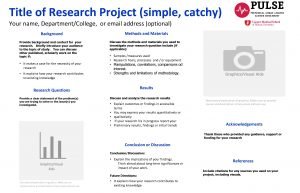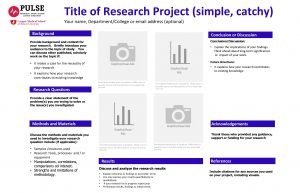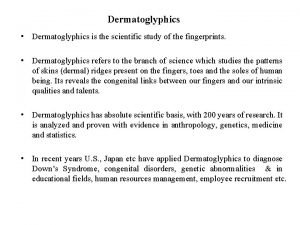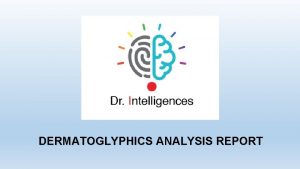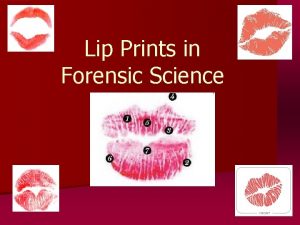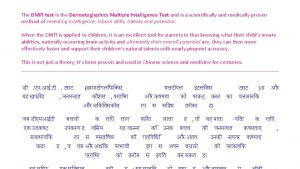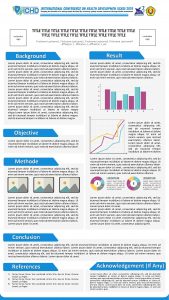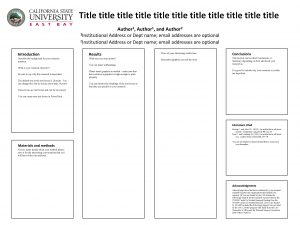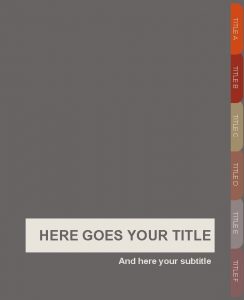Title of the research project Cheiloscopy and Dermatoglyphics





































- Slides: 37

Title of the research project: Cheiloscopy and Dermatoglyphics for gender determination and personal identification: A descriptive study. Candidate Dr. Tim Peter - Ph. D Scholar Yenepoya University Mangalore, Karnataka. - Assistant Professor, Dept. of Oral Medicine and Radiology, KMCT Dental College, Calicut, Kerala. Guide Prof. Laxmikanth Chatra Prof. & HOD, Dept. of Oral Medicine and Radiology Yenepoya University Mangalore, Karnataka. Co Guide Prof. Auswaf Ahsan Prof. & HOD, Dept. of Oral Medicine and Radiology, KMCT Dental College, Calicut, Kerala. 1

Contents • • • Introduction and Background Literature Survey Present status- International National and Local scenarios Social relevance and uniqueness of the work Aim, Objectives and Hypothesis Informed Consent Materials and Methodology Statistical Analysis Timeline of project References 2

Introduction and Background • Cheiloscopy is derived from the Greek word cheilos (which means lips) and skopein (which means to see). (Prabhu et al. , 2012) • A forensic investigation technique that deals with identification based on lip groove patterns. (Rohit M et al. , 2011) 3

Dermatoglyphics • Study of fingerprints. (Nagasupriya A et al. , 2011) • A friction ridge is a raised portion of the epidermis on the digits or on the palmar and plantar skin, consisting of one or more connected ridge units of friction ridge skin. (Rastogi P et al. , 2010) • Unique and stable. (Rastogi P et al. , 2010) ) 4

• The development of dermatoglyphic patterns begins with 6 th week & ends in the 24 th week of gestation (Mulvihill et al, 1969; Babler et al, 1978, 1979; Babler et al, 1991). • From this stage onwards, patterns are unaffected by the environment, and this explains their unique role, as an ideal marker for individual identification (Cummins, 1961; Livshits et al, 1991). 5

• Dermatoglyphic patterns are unique in every individual and by examining them several parameters can be studied, for possible associations with specific diseases (Stosljeviu et al, 2013). 6

Literature Survey • Contradictory results were found in the gender determination potential of cheiloscopy. • Positive aid in gender determination. (Bharathi S et al. , 2015, Girish R et al. , 2013) • Accuracy in gender determination in males (17. 4 %) and in females (35. 4 %). (Kaul et al. , 2015) • Call for further research in view of an established result still persist. 7

International Scenario • Type 1 lip groove patterns are seen in males (53. 37 %) and females (60. 07 %) of Libya. (Syed et al. , 2015) • Uniqueness of lip grooves are proven in Nigeria, but further studies with larger samples are called for statistical significance. (Obik et al. , 2014) • Comparitive study between Indian and Malaysian students revealed Type I common among both groups and no significant difference among gender. (Bhuvan Nagpal et al. , 2015) 8

National Scenario • Type III were common among males and Type II were common among females in Pondicherry population. (Satish Kumar et al. , 2012) • Males donot exhibit Type II or Type III in Uttar Pradesh population; which has contradictory results. (Bushra Karim et al. , 2015) • Type I and Type I’ were common in females; Type IV and Type V were common in males among Nagpur population. (Dongarwar et al. , 2014) 9

National Scenario • Type I and Type I’ were common among females; Type IV and Type V were common among males in Nagpur population. (Girish R et al 2013) • Similar results among males and contradictory results among females were seen in Modinagar population. (Vikash et al 2014) 10

National Scenario • More studies on lip groove pattern is needed to bring out the newer dimension to forensic anthropology. (Yogesh et al. , 2012) • Contradictory results were shown in relation to lip groove patterns among Lucknow population. (B J Adams et al. , 2003) • Type III and Type II were found common in males and females respectively in Mangalore. (Junaid Ahmed et al. , 2014) 11

Local Scenario • Type IV was reported as the common pattern among both gender in Kerala population and no significant difference among gender was reported. (Annie et al. , 2001) • However, further studies are called for in this regard for an established conclusion. (Annie et al. , 2001) 12

Social Relevance and Uniqueness of the work • Nirbhaya case, Delhi - Dr. Ashith Acharya • Cheiloscopy and Dermatoglyphics – Potential tools for the same. 13

Aim • To analyse whether gender determination can be made by using dermatoglyphics and cheiloscopy. 14

Objectives • To determine the common lip groove line in sample population. • To determine the common finger print pattern in sample population. • To analyse whethere is a relationship between cheiloscopy and dermatoglyphics of an individual. • To analyse whether cheiloscopy and dermatoglyphics can be confirmed as a personal identification criteria. 15

Methodology – Sample Size, Selection Criteria, Tests Sample Size: It is a time bound study based on outpatients cases in the dental college. 2112 patients samples will be obtained based on the prevalance formula. 16

Sample Size • Sample size for the survey study • N = Z 2 α/2 × p×(1 - p) ×D E 2 Z α/2 = Normal deviate for two tailed hypothesis =1. 96 P = Proportion Or Prevalence (From Previous Studies) = 67. 5 % (Monica Kinra et al 2014) D = Design effect= 1 E = Margin of error =2% – Sample will be collected from KMCT Dental College and hospital, Calicut. 17

Selection Criteria • Inclusion Criteria: - Individuals aged between 18 years and 60 years with lips and fingers free from any pathology (congenital and acquired) and having normal transition zone between the mucosa and skin. 18

• Exclusion Criteria: - Individuals with known allergy to lipstick and colouring medium. - Individuals with inflammation of lips and fingers following trauma, malformation, deformity, surgical scars, facial palsy and active lesions of the lips and fingers. - Non ambulatory patients. 19

Ethical Clearance – Institutional ethical clearance was taken from KMCT Dental College, Calicut. – Samples were collected after informed consent from the individual. 20

INFORMED CONSENT FORM Cheiloscopy and Dermatoglyphics for gender determination and personal identification: A descriptive study. (KMCT Dental College, Calicut, Kerala. ) Name of the patient: Age: Sex: Address: Exercising free power of choice, I am hereby giving my written consent to be included as subject in the study “Cheiloscopy and Dermatoglyphics for gender determination and personal identification: A descriptive study”, conducted by Dr. Tim Peter. I have been informed in the language which I understand, by the investigator about the purpose, advantages, risks and benefits of the study. I was given opportunity to discuss and to seek clarification on each and every aspect of this study. I willingly declare to participate in this study. Signature of patient Signature of researcher 21

• Methodology: Recording of finger print pattern • Finger print recording will be done by asking the subjects to ink all their finger pads, both right and left hands, and the impression will be recorded on a white bond paper. [Alter et al, 1970]. • Then the finger print pattern will be studied with the help of magnifying lens and the predominant pattern of 10 finger pads (in each subject) will be quantified tabulated analysed statistically. 22

Examination of dermatoglyphic patterns: Quantitative and qualitative variables Ridge count - Ridge count of thumb, index, middle, ring and little fingers of both hands. - Right hand total finger ridge count (TFRC). - Left hand total finger ridge count (TFRC). - Absolute finger ridge count (AFRC). 23

Qualitative variables - Arch (simple arch, tented arch), - Loop (ulnar loop and radial loop) and - Whorl (simple, spiral, double pocket, composite) patterns. 24

Statistical analysis • Descriptive Statistics (Mean) will be used to summarize the data. • Normality of the data will be assessed by Kolmogrov-Smirnov Test. • If data follows normal distribution, Independent ‘t’ test will be used. • If data follows non-normal distribution, Mann-Whitney ‘U’ test will be used. • Chi square test: for association of qualitative variables. • Pearson’s Correlation for assessing the correlation between cheiloscopy and dermatoglyphics 25

Results and Conclusions so far • 280 samples were collected as on 29/03/2017. • Collected data was tabulated in excel sheet. • Finger print patterns and lip groove patterns were tabulated qualitatively and quantitatively. 26

Finger print Pattern: Qualitative Analysis 27

Finger Print Pattern: Quantitative Analysis 28

Lip groove Pattern: Qualitative and Quantitative Analysis 29

Proposed work for the rest of the study duration • Data collection will be proceeded from April, 2017 at around 90 individuals in a month. • Literature survey and meta analysis of cheiloscopy and dermatoglyphics in relation to gender determination will be continued. 30

Time line of the study • January 2015: Registered for Ph. D Program, YU • SRC (Scientific Review Committee) ceritficate and IEC (Institutional Ethical Committee) certificate obtained. • January 2017 – December 2018: Data Collection. • 2019 January – 2019 December: Statistical Analysis, Interpretation, Writing and Submission of Thesis. 31

References 1. Rohit M, Sumit G. Cheiloscopy: A Deterministic Aid for Forensic Sex Determination. Journal of Indian academy of Oral Medicine and Radiology. 2011; 23: 17 -19. 2. Nagasupriya A, Dhanapal R, Reena K, Saraswathi T, Ramachandran C. Patterns‑“A crime solver”. J Forensic Dent Sci 2011; 3: 3‑ 7. 3. Rastogi P, Pillai KR. A study of finger prints in relation to gender and blood groups. J Indian Acad Forensic Med 2010; 32: 11‑ 4. 4. Mulvihill JJ, Smith DW. The genesis of dermatoglyphics. J Pediatr. 1969; 75: 579 589. 5. Babler W. J. Prenatal selection and dermatoglyphic patterns. Am J Phys Anthrop. 1978; 48: 21 -28. 6. Babler WJ. Quantitative differences in morphogenesis of human epidermal ridges in “Dermatoglyphics: fifty years later”. Birth Defects. 1979; 15(6): 199– 208. 32

7. Babler WJ. Embryologic development of epidermal ridges and their configurations. Birth defects. 1991; 27(2): 95– 112. 8. Cummins H, Midlo C. Finger Prints, Palms and Soles. Philadephia, Blakiston, 1943. Reprinted New York, Dover, 1961. 319 pp 9. Livshits G, Kobyliansky E. Fluctuating asymmetry as possible measure of the developmental homeostasis in humans. Hum. Biol. 1991; 63: 441– 466. 10. Bharathi S, Thenmozhi M s. Cheiloscopy - Lip print , An determination of sex and individual. I J. Pharm. Sci & Res. 2015; 7(6): 330 -3. 11. Girish R Dongarwar, Rahul R Bhowate, Shirish S Degwekar. Cheiloscopy- Method of person identification and sex determination. 2013; 2(1): 1 -4. 12. Rachana Kaul, Shreenivasa Murthy Padmashree, Padar Shastry Shilpa, Nishat Sultana, Suraksha Bhat. Cheiloscopic patterns in Indian population and their efficacy in sex determination: A randomized cross sectional study. 2015; 7(2): 101 -6. 33

13. Junaid Ahmed, Ravikiran Ongole, Ceena Denny E, Nandita Shenoy, Almas Binnal. Scope of cheiloscopy in gender identification. International Journal of Biomedical Research. 2014; 5(6): 423 -6. 14. Girsh R Dongarwar, Rahul R Bhowate, Shirish S Degwekar. Cheiloscopy Method of Person Identification and Sex Determination. 2013; 2(1): 1 -4. 15. Alter M, Schulenberg R. Dermatoglyphics in congenital heart disease. Circulation. 1970; 41: 49 -54. 16. Sandhu S V, Bansal H, Monga P, Bhandari R Study of lip print in a Punjabi population. Journal of Forensic Dental Sciences. 2012; 4(1): 24 -8. 17. Annie J Varghese, Shashidhar C Mestri. A study of efficacy of lip prints as an identification toolamong the people of Karnataka in India. Journal of Indian Academy of Forensic. Medicine. 2011; 33(3): 200 -2. 18. T R Saraswathi, G Mishra, K Ranganathan. 2009. Study of lip prints. Journal of Forensic Dental Sciences. 2009; 1: 28 -31. 34

19. P Raghav, N Kumar, S Shingh, N K Ahuja, P Ghalaut. Lip prints: The barcode of skeletal malocclusion. Journal of Forensic Dental Sciences. 2013; 5(2): 110 -7. 20. Venkatesh R, David MP. Cheiloscopy: An aid for personal identification. Journal of Forensic Dental Sciences. 2011; 3(2): 67 -70. 21. Preeti Sharma, Susmita. Saxena, Vanita. Rathod. Comparative reliability of cheiloscopy and palatoscopy inhuman identification. Indian Journal of Dental Research. 2009; 20: 453 -7. 22. Anju Devi, Madhusudan. Astekar, Vinay Kumar, Prabhpreet Kaur, Navneet Singh, Gagandeep Kaur Sidhu. The study of inheritance analysis and evaluation of lip prints in individuals. Journal of Forensic Dental Sciences. 2015; 7(1): 49 -53. 23. Padmavathi. BN, Ramanpal Singh Makkad, S Y Rajan, Gopi Krishna Kolli. Gender determination using cheiloscopy. Journal of Forensic Dental Sciences. 2013; 5(2): 123 -8. 24. Augustine J, Barpande SR, Tupkari JV. Cheiloscopy as an adjunct to forensic identification: a study of 600 individuals. Journal of Forensic Odontostomatology. 2008; 26(2): 44 -52. 35

25. Osama R El Ghamry, Amany M Abdullatif, Ayman K Ismail. Duration of reliability of lip print as physical evidence at scene of a crime. International Research Journal of Applied and Basic Sciences. 2014; 8(1): 26 -33. 26. Peeran SW, Kumar N G P, Abdalla K A, Azaruk F A A, Manipady S, Alsaid F M. A study of lip print patterns among adults of Sebha city, Libya. Journal of Forensic Dental Sciences. 2015; 7(1): 67 -71. 27. Bhat P, Badiyani B, Aruna CN, Chengappa S, Bhaskar N. Dermatoglyphics- A new diagnostic tool in detection of dental caries among deaf and mute children. Int J Clin Dent Sci 2011; 2: 80 -4. 28. P E O Shaughnessy. Introduction to Forensic Science. Dental Clinics North America. 2001; 45(2): 217 -27. 29. Kasprzak J. Cheiloscopy. Encyclopedia of Forensic Sciences. London: Academic Press. 2000; 1: 358 -61. 36

Thank You 37
 Appendicular bisector
Appendicular bisector Cheiloscopy definition
Cheiloscopy definition Dermatoglyphics fingerprint analysis
Dermatoglyphics fingerprint analysis Cheiloscopy definition
Cheiloscopy definition Cheiloscopy definition
Cheiloscopy definition Catchy titles for presentations
Catchy titles for presentations Research project title
Research project title Research project name
Research project name Title fly and title page
Title fly and title page Title title
Title title Project title for health and nutrition
Project title for health and nutrition Hát kết hợp bộ gõ cơ thể
Hát kết hợp bộ gõ cơ thể Bổ thể
Bổ thể Tỉ lệ cơ thể trẻ em
Tỉ lệ cơ thể trẻ em Chó sói
Chó sói Glasgow thang điểm
Glasgow thang điểm Chúa yêu trần thế
Chúa yêu trần thế Kể tên các môn thể thao
Kể tên các môn thể thao Thế nào là hệ số cao nhất
Thế nào là hệ số cao nhất Các châu lục và đại dương trên thế giới
Các châu lục và đại dương trên thế giới Công thức tính độ biến thiên đông lượng
Công thức tính độ biến thiên đông lượng Trời xanh đây là của chúng ta thể thơ
Trời xanh đây là của chúng ta thể thơ Mật thư anh em như thể tay chân
Mật thư anh em như thể tay chân 101012 bằng
101012 bằng độ dài liên kết
độ dài liên kết Các châu lục và đại dương trên thế giới
Các châu lục và đại dương trên thế giới Thể thơ truyền thống
Thể thơ truyền thống Quá trình desamine hóa có thể tạo ra
Quá trình desamine hóa có thể tạo ra Một số thể thơ truyền thống
Một số thể thơ truyền thống Cái miệng xinh xinh thế chỉ nói điều hay thôi
Cái miệng xinh xinh thế chỉ nói điều hay thôi Vẽ hình chiếu vuông góc của vật thể sau
Vẽ hình chiếu vuông góc của vật thể sau Nguyên nhân của sự mỏi cơ sinh 8
Nguyên nhân của sự mỏi cơ sinh 8 đặc điểm cơ thể của người tối cổ
đặc điểm cơ thể của người tối cổ Thế nào là giọng cùng tên? *
Thế nào là giọng cùng tên? * Vẽ hình chiếu đứng bằng cạnh của vật thể
Vẽ hình chiếu đứng bằng cạnh của vật thể Fecboak
Fecboak Thẻ vin
Thẻ vin


